
People gather to protest the Japanese government and Tokyo Electric Power Company's (TEPCO) decision on releasing nuclear-contaminated wastewater in front of the headquarters of the TEPCO in Tokyo, Japan, Aug. 24, 2023. Despite public concerns and raging opposition from both home and abroad, Japan started releasing nuclear-contaminated wastewater from the crippled Fukushima Daiichi Nuclear Power Plant into the Pacific Ocean on Thursday. (Xinhua/Yang Guang)
TOKYO, Aug. 24 (Xinhua) -- Japan has started releasing nuclear-contaminated wastewater from the crippled Fukushima Daiichi Nuclear Power Plant into the Pacific Ocean on Thursday, while hundreds of Japanese gathered in central Tokyo to rally against the discharge plan.
Live video provided by the plant operator Tokyo Electric Power Company (TEPCO) showed that a staff member turned on a seawater pump at around 1:00 p.m. local time (0400 GMT), marking the beginning of the controversial ocean discharge, while concerns and opposition persisted among local fishermen as well as in neighboring countries and Pacific island countries.
The radioactive wastewater has been diluted as planned before being discharged via an underwater tunnel 1 km from the plant, according to TEPCO.
Under scorching heat, hundreds of Japanese from all across the country gathered in front of the TEPCO headquarters in central Tokyo on Thursday morning, demanding the Japanese government and TEPCO to stop the ocean release.
Protesters, holding banners and placards with drawings of marine products and Godzilla, chanted slogans of "No ocean discharge of Fukushima nuclear-tainted water" and "Stop polluting the sea with radioactive water."
Taeko Fujimura with Japan's National Federation of Agricultural Cooperative Associations, also known as Zen-Noh, said the ocean discharge "cannot be forgiven" and was "extremely unreasonable."
"Have you now obtained the understanding of the relevant parties? Have you properly explained your actions to them?" Fujimura shouted the questions amid the crowd of protesters.
The Zen-Noh official told Xinhua that in Zen-Noh's previous talks with TEPCO, it clearly stated that apart from tritium, there are various other radioactive substances that will remain in the tainted water in large amounts even after the second round of ALPS treatment.
Fujimura stressed that the ocean discharge, which is to continue for at least 30 years, will cause significant environmental damage. "It will pollute the sea, the marine life within it, the environment, and the Earth."
"We, as the agricultural cooperative, cannot allow such destructive actions by TEPCO. Even if we have been deceived for the time being, we must stop the ocean discharge as soon as possible," she added.
Among the protesters was Sachiko Uno, who told Xinhua that she came to "stop them from polluting the ocean."
"One of the world's top-level nuclear accidents occurred in Fukushima despite safety promises made by the government and TEPCO. Now, they have become the world's first by beginning to discharge nuclear-contaminated water into the ocean. This is a 'double damage,'" said the 73-year-old woman.
Uno is also concerned with TEPCO's credibility. "It says the radioactivity concentration in the nuclear-contaminated water meets the standards, but I can't believe that at all. The reliability of the measuring instruments themselves is questionable," she said.
Hit by a magnitude-9.0 earthquake and an ensuing tsunami on March 11, 2011, the Fukushima plant suffered core meltdowns that released radiation, resulting in a level-7 nuclear accident, the highest on the International Nuclear and Radiological Event Scale.
The plant has been generating a massive amount of water tainted with radioactive substances from cooling down the nuclear fuel in the reactor buildings, which are now being stored in about 1,000 storage tanks.
TEPCO said it plans to carry out the first round of release over the next 17 days to discharge 7,800 tons of the radioactive wastewater.
In the current fiscal year through next March, a total of 31,200 tons are slated for discharge, equivalent to the storage capacity of 30 tanks, TEPCO added. ■

People gather to protest the Japanese government and Tokyo Electric Power Company's (TEPCO) decision on releasing nuclear-contaminated wastewater in front of the headquarters of the TEPCO in Tokyo, Japan, Aug. 24, 2023. Despite public concerns and raging opposition from both home and abroad, Japan started releasing nuclear-contaminated wastewater from the crippled Fukushima Daiichi Nuclear Power Plant into the Pacific Ocean on Thursday. (Xinhua/Yang Guang)

A man protests against the Japanese government and Tokyo Electric Power Company's (TEPCO) decision on releasing nuclear-contaminated wastewater in front of the headquarters of the TEPCO in Tokyo, Japan, Aug. 24, 2023. Despite public concerns and raging opposition from both home and abroad, Japan started releasing nuclear-contaminated wastewater from the crippled Fukushima Daiichi Nuclear Power Plant into the Pacific Ocean on Thursday. (Xinhua/Yang Guang)

People gather to protest the Japanese government and Tokyo Electric Power Company's (TEPCO) decision on releasing nuclear-contaminated wastewater in front of the headquarters of the TEPCO in Tokyo, Japan, Aug. 24, 2023. Despite public concerns and raging opposition from both home and abroad, Japan started releasing nuclear-contaminated wastewater from the crippled Fukushima Daiichi Nuclear Power Plant into the Pacific Ocean on Thursday. (Xinhua/Yang Guang)

A citizen protests against the Japanese government and Tokyo Electric Power Company's (TEPCO) decision on releasing nuclear-contaminated wastewater in front of the headquarters of the TEPCO in Tokyo, Japan, Aug. 24, 2023. Despite public concerns and raging opposition from both home and abroad, Japan started releasing nuclear-contaminated wastewater from the crippled Fukushima Daiichi Nuclear Power Plant into the Pacific Ocean on Thursday. (Xinhua/Yang Guang)

People gather to protest the Japanese government and Tokyo Electric Power Company's (TEPCO) decision on releasing nuclear-contaminated wastewater in front of the headquarters of the TEPCO in Tokyo, Japan, Aug. 24, 2023. Despite public concerns and raging opposition from both home and abroad, Japan started releasing nuclear-contaminated wastewater from the crippled Fukushima Daiichi Nuclear Power Plant into the Pacific Ocean on Thursday. (Xinhua/Yang Guang)
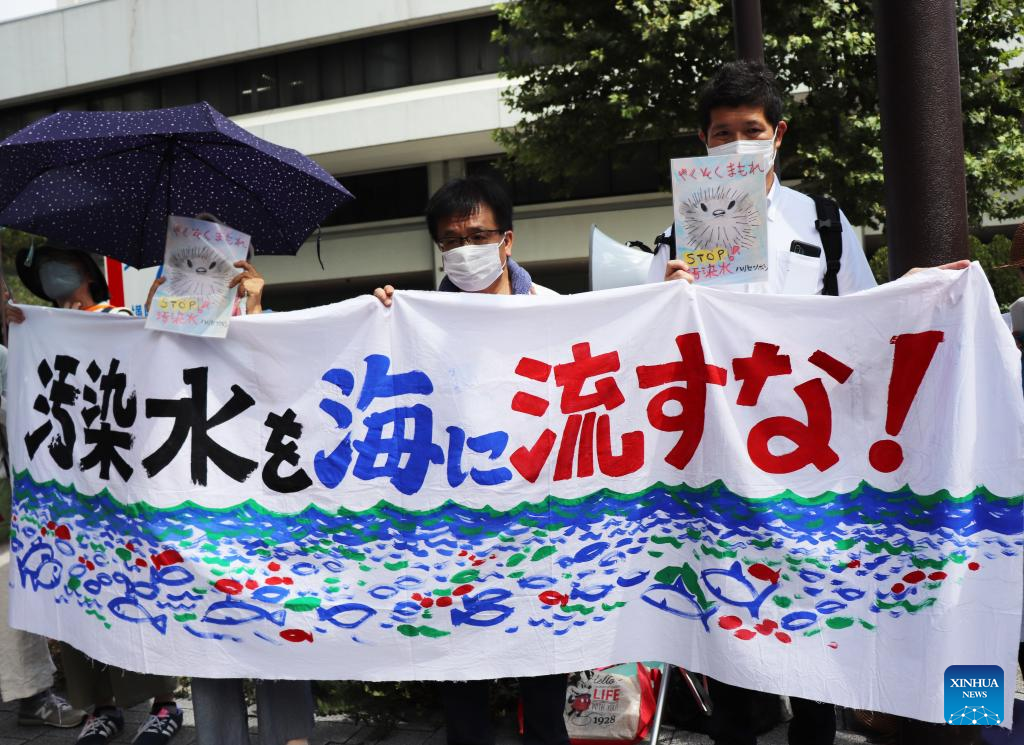
People gather to protest the Japanese government and Tokyo Electric Power Company's (TEPCO) decision on releasing nuclear-contaminated wastewater in front of the headquarters of the TEPCO in Tokyo, Japan, Aug. 24, 2023. Despite public concerns and raging opposition from both home and abroad, Japan started releasing nuclear-contaminated wastewater from the crippled Fukushima Daiichi Nuclear Power Plant into the Pacific Ocean on Thursday. (Xinhua/Yang Guang)
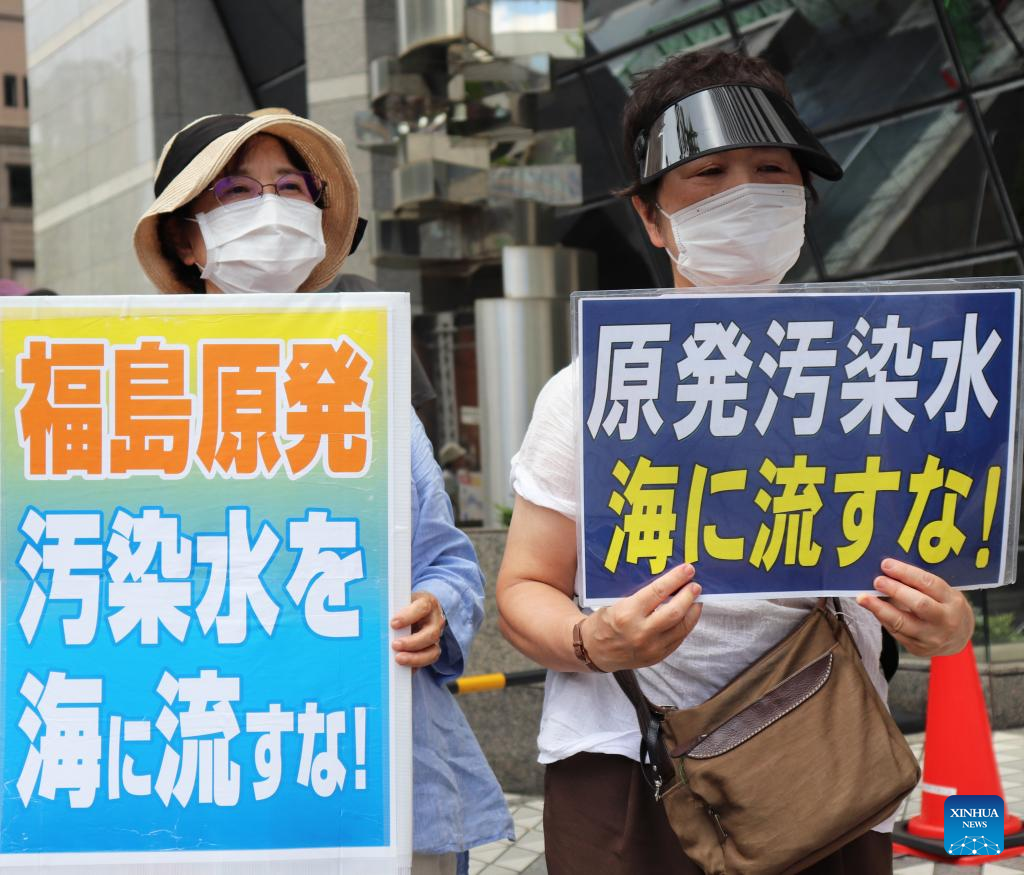
People gather to protest the Japanese government and Tokyo Electric Power Company's (TEPCO) decision on releasing nuclear-contaminated wastewater in front of the headquarters of the TEPCO in Tokyo, Japan, Aug. 24, 2023. Despite public concerns and raging opposition from both home and abroad, Japan started releasing nuclear-contaminated wastewater from the crippled Fukushima Daiichi Nuclear Power Plant into the Pacific Ocean on Thursday. (Xinhua/Yang Guang)
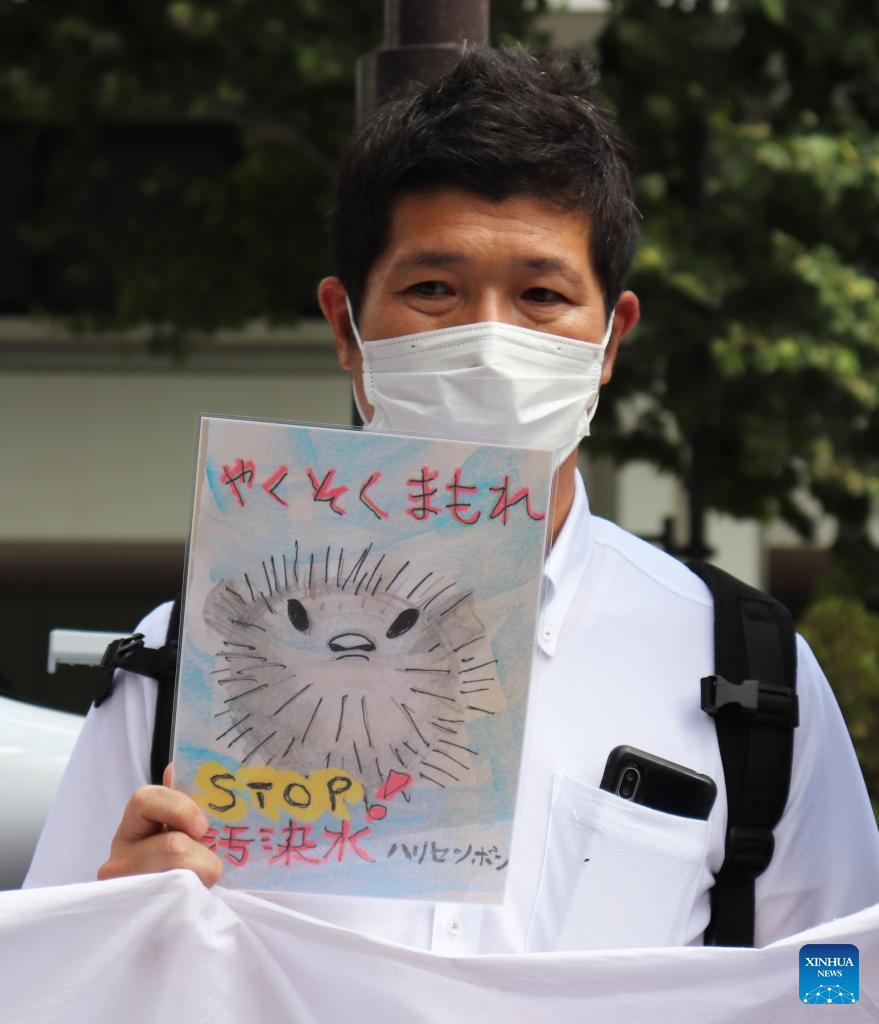
A man protests against the Japanese government and Tokyo Electric Power Company's (TEPCO) decision on releasing nuclear-contaminated wastewater in front of the headquarters of the TEPCO in Tokyo, Japan, Aug. 24, 2023. Despite public concerns and raging opposition from both home and abroad, Japan started releasing nuclear-contaminated wastewater from the crippled Fukushima Daiichi Nuclear Power Plant into the Pacific Ocean on Thursday. (Xinhua/Yang Guang)
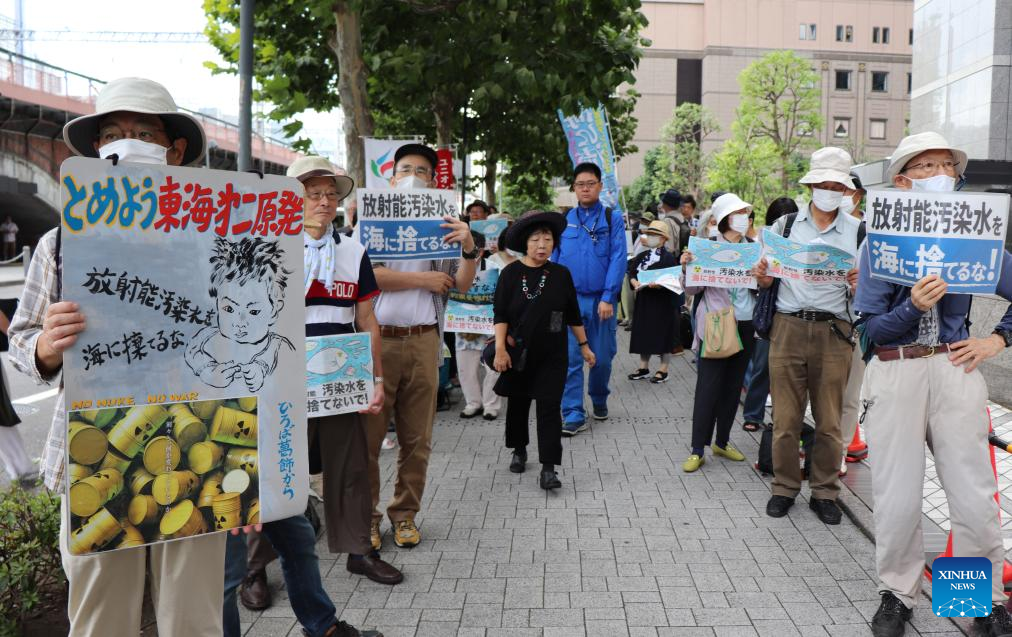
People gather to protest the Japanese government and Tokyo Electric Power Company's (TEPCO) decision on releasing nuclear-contaminated wastewater in front of the headquarters of the TEPCO in Tokyo, Japan, Aug. 24, 2023. Despite public concerns and raging opposition from both home and abroad, Japan started releasing nuclear-contaminated wastewater from the crippled Fukushima Daiichi Nuclear Power Plant into the Pacific Ocean on Thursday. (Xinhua/Yang Guang)
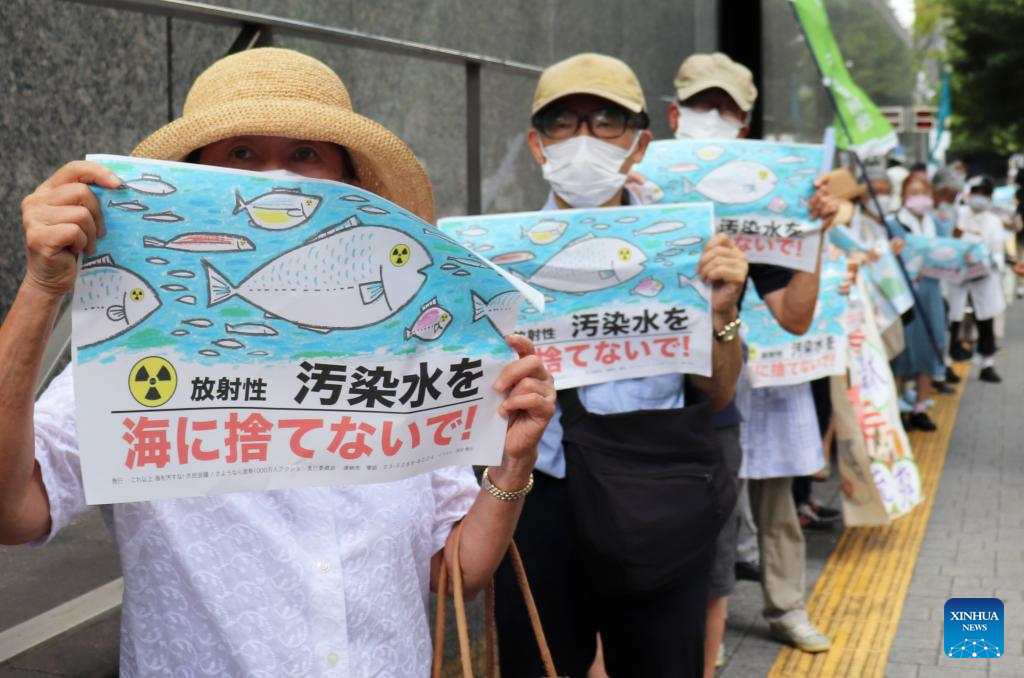
People gather to protest the Japanese government and Tokyo Electric Power Company's (TEPCO) decision on releasing nuclear-contaminated wastewater in front of the headquarters of the TEPCO in Tokyo, Japan, Aug. 24, 2023. Despite public concerns and raging opposition from both home and abroad, Japan started releasing nuclear-contaminated wastewater from the crippled Fukushima Daiichi Nuclear Power Plant into the Pacific Ocean on Thursday. (Xinhua/Yang Guang)

A citizen protests against the Japanese government and Tokyo Electric Power Company's (TEPCO) decision on releasing nuclear-contaminated wastewater in front of the headquarters of the TEPCO in Tokyo, Japan, Aug. 24, 2023. Despite public concerns and raging opposition from both home and abroad, Japan started releasing nuclear-contaminated wastewater from the crippled Fukushima Daiichi Nuclear Power Plant into the Pacific Ocean on Thursday. (Xinhua/Yang Guang)
信息網(wǎng)絡(luò)傳播視聽(tīng)節(jié)目許可證:120330032
中華人民共和國(guó)互聯(lián)網(wǎng)新聞信息服務(wù)許可證:45120170002
中華人民共和國(guó)互聯(lián)網(wǎng)出版許可證 (署)網(wǎng)出證(桂)字第020號(hào)
廣播電視節(jié)目制作經(jīng)營(yíng)許可證編號(hào):(桂)字第0230號(hào)
網(wǎng)警備案號(hào):45010302000253
桂ICP備11003557 南寧新聞網(wǎng)版權(quán)所有
舉報(bào)電話:0771—5530647 郵箱:mail@nnnews.net
登錄
還沒(méi)賬號(hào)?立即注冊(cè)
點(diǎn)擊頭像快速登錄
請(qǐng)輸入驗(yàn)證碼